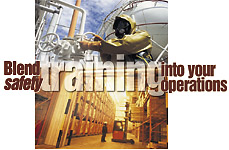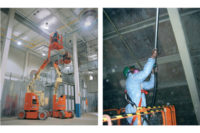
The training process. It's been written about at length for decades, and there are countless varieties of systems and approaches to choose from. The essence of the process, however, boils down to four phases: development, delivery, evaluation and management.
Development
Development includes all the activities involved in preparing the training. It begins with the question "Is training needed?" Sometimes problems in the workplace are identified as training problems when, in fact, they are process design, supervisory, motivation and/or discipline problems.For example, if personnel are not wearing gloves for a task that requires them, there may be a number of causes for the lack of compliance. The correct gloves may not available or only available through an unnecessarily complicated process. Perhaps supervision does not insist upon the use of gloves. The gloves might be uncomfortable. Lastly, the workers might not be properly trained on the importance of using gloves for the task or the consequences of not using them properly.
If training is the solution then the development process should next identify what the training must include. Have a clear picture in your mind of what successful performance looks like at the beginning of the development process. The key question here is, "What must the audience know and be able to do after the training is completed?" Referred to as the task analysis, this determination should initially result in a list of individual bits of knowledge or skills that a person would need in order to successfully accomplish the task. It is critical to involve those who currently perform the task in this process both in discussion and through observation.
After preparing the task analysis, the individual items on the list of tasks may be converted into performance objectives - brief statements of the expected outcome of an individual piece of the training program. These provide a clear view of what successful performance of each item looks like. For example, an emergency response team member, while wearing protective clothing, will demonstrate completely how to don a self-contained breathing apparatus from its case and be breathing from the unit within one minute without missing any critical steps.
Delivery
Delivery deals with how you're going to present the training to an audience. Training may be conducted in a wide variety of ways. No single method or technique is adequate for all needs, and, no approach is completely without merit. This brief article cannot address all methods but will examine a few of the more common safety training programs.The term "safety training program" is one of my personal pet peeves. As long as safety training is conducted separately from other workplace training it will not become integrated into your processes. Separate safety training tends to give the impression that there is a productive way to do a task and a safe way to do the task and that these methods may not be the same. When training a lathe operator, for example, safety issues should be built into the lathe operation training.
Instructor-led training may be conducted in the classroom or in the work environment. Traditional classroom training still offers many advantages. The interaction between the instructor and student and among the students is often a valuable part of the training process. A good trainer can modify the class as training progresses to cope with the needs of the students.
On-the-job training is another type of instructor leading training. This is typically conducted one-on-one and is probably one of the best methods for presenting training on complex subjects.
Technology-based training, which offers considerable scheduling flexibility, involves computer-based programs, including those accessed via the Internet. Video-based training, which can be designed for use with limited or no involvement of an instructor, is also in this category. This type of training can be effective for knowledge-based instruction, such as making students aware of regulatory requirements.
Evaluation
Evaluation of the impact of training is one of the weakest points in the typical training process. Part of the problem is that effective evaluation of training is not easy. Tests during the program for technology-based training or at the end of an instructor-led program offer little information beyond a person's ability to maintain a short-term memory of the information presented. Results of these tests are heavily influenced by the quality of the test, the individual's feeling about tests, and his or her general knowledge of test-taking strategy. With technology-based training the system will usually take the user back to the question repeatedly until they get it correct.The best evaluation of a training program is the impact the training has had on actual performance. This is generally difficult to do and even more challenging to do objectively. With emergency response training, for example, we would rather the trainees not use the skills they have acquired during an actual emergency. Non-emergency situations also offer many challenges to objective evaluation. One of the more significant issues is the Hawthorne effect. This theory indicates that the presence of observers has an impact on the observed behavior and performance.
Often the best way to evaluate training, short of actual performance, is with simulations, exercises and drills. One of the advantages of these constructed situations is that they may be conducted independent of the work process. To evaluate respirator selection, inspection and use, you might have to observe a worker for a long period of time before this behavior is required in the work setting. By providing a simulation you can schedule the event.
Process management
Management of the training process must include ensuring that the individuals who require training get what they need. If training is being conducted purely to meet a regulatory requirement remember that you can take advantage of some synergy in the requirements. For example, if you have hazmat responders, then the hours they spend in respiratory protection training under OSHA 1910.134 may be counted toward the hours required under 1910.120. You are not required to duplicate this training.Managing training also means ensuring that the people who require training receive it when they need it. Scheduling can often be a difficult aspect of managing the training process. This scheduling challenge is a part of what's driving the move to technology-based training for many topics.
A relatively new resource for trainers is the ANSI Z40.1 "Criteria for Accepted Practices in Safety, Health and Environmental Training." This standard is available from the American Society of Safety Engineers.
Effective training can have a positive impact on performance; poor training is a waste of everyone's time. Integrate safety training into normal work training whenever possible. Effective training should be aimed at clear and specific objectives that have been tailored to your organization's needs.
SIDEBAR: Keys to the Development Phase
When you are in the development phase of the training process, i.e. preparing the training, keep in mind these key considerations:- Use action verbs in the training materials and teaching curriculum.
- Emphasize observable and measurable outcomes.
- Avoid ambiguous terms such as "understand."
- Decide which delivery methods will be used, as the method(s) used will impact development. For example, classroom instruction materials will vary greatly from the materials needed if computer-based delivery is used.
- Prepare all training materials; these could include handouts, manuals, audio/visual presentations, and other items.
- Prepare evaluation methods during the development phase.
